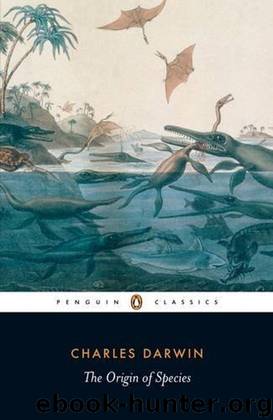The Origin of Species by Means of Natural Selection by Charles Darwin

Author:Charles Darwin
Language: eng
Format: epub
Publisher: Penguin Books Ltd
Published: 1968-08-07T16:00:00+00:00
CHAPTER VIII
HYBRIDISM
Distinction between the sterility of first crosses and of hybrids – Sterility various in degree, not universal, affected by close interbreeding, removed by domestication – Laws governing the sterility of hybrids – Sterility not a special endowment, but incidental on other differences – Causes of the sterility of first crosses and of hybrids – Parallelism between the effects of changed conditions of life and crossing – Fertility of varieties when crossed and of their mongrel offspring not universal – Hybrids and mongrels compared independently of their fertility – Summary
THE view generally entertained by naturalists is that species, when intercrossed, have been specially endowed with the quality of sterility, in order to prevent the confusion of all organic forms. This view certainly seems at first probable, for species within the same country could hardly have kept distinct had they been capable of crossing freely. The importance of the fact that hybrids are very generally sterile, has, I think, been much underrated by some late writers. On the theory of natural selection the case is especially important, inasmuch as the sterility of hybrids could not possibly be of any advantage to them, and therefore could not have been acquired by the continued preservation of successive profitable degrees of sterility. I hope, however, to be able to show that sterility is not a specially acquired or endowed quality, but is incidental on other acquired differences.
In treating this subject, two classes of facts, to a large extent fundamentally different, have generally been confounded together; namely, the sterility of two species when first crossed, and the sterility of the hybrids produced from them.
Pure species have of course their organs of reproduction in a perfect condition, yet when intercrossed they produce either few or no offspring. Hybrids, on the other hand, have their reproductive organs functionally impotent, as may be clearly seen in the state of the male element in both plants and animals; though the organs themselves are perfect in structure, as far as the microscope reveals. In the first case the two sexual elements which go to form the embryo are perfect; in the second case they are either not at all developed, or are imperfectly developed. This distinction is important, when the cause of the sterility, which is common to the two cases, has to be considered. The distinction has probably been slurred over, owing to the sterility in both cases being looked on as a special endowment, beyond the province of our reasoning powers.
The fertility of varieties, that is of the forms known or believed to have descended from common parents, when intercrossed, and likewise the fertility of their mongrel offspring, is, on my theory, of equal importance with the sterility of species; for it seems to make a broad and clear distinction between varieties and species.
First, for the sterility of species when crossed and of their hybrid offspring. It is impossible to study the several memoirs and works of those two conscientious and admirable observers, Kölreuter and Gärtner, who almost
Download
This site does not store any files on its server. We only index and link to content provided by other sites. Please contact the content providers to delete copyright contents if any and email us, we'll remove relevant links or contents immediately.
Sapiens: A Brief History of Humankind by Yuval Noah Harari(14216)
Sapiens by Yuval Noah Harari(5281)
Pale Blue Dot by Carl Sagan(4886)
Homo Deus: A Brief History of Tomorrow by Yuval Noah Harari(4801)
Livewired by David Eagleman(3663)
Origin Story: A Big History of Everything by David Christian(3632)
Brief Answers to the Big Questions by Stephen Hawking(3358)
Inferior by Angela Saini(3260)
Origin Story by David Christian(3133)
Signature in the Cell: DNA and the Evidence for Intelligent Design by Stephen C. Meyer(3055)
The Gene: An Intimate History by Siddhartha Mukherjee(3029)
The Evolution of Beauty by Richard O. Prum(2925)
Aliens by Jim Al-Khalili(2776)
How The Mind Works by Steven Pinker(2714)
A Short History of Nearly Everything by Bryson Bill(2616)
Sex at Dawn: The Prehistoric Origins of Modern Sexuality by Ryan Christopher(2472)
From Bacteria to Bach and Back by Daniel C. Dennett(2432)
Endless Forms Most Beautiful by Sean B. Carroll(2414)
Who We Are and How We Got Here by David Reich(2385)
